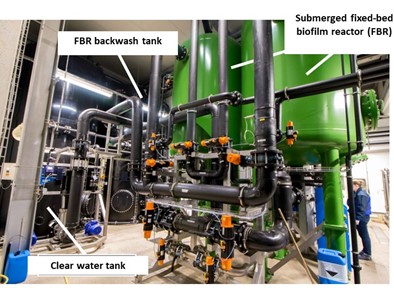
Unique selling points
- Removal of dissolved organic matter and suspended solids in reactor
- Removal of complex organic compounds such as micropollutants
- Compact system
Description of the technology
Biofilm processes are biological wastewater treatment processes in which active biomass is not (only) present in suspended form (activated sludge systems) but is fixed on carrier materials. Microorganisms involved are similar to the ones present in activated sludge reactor systems which is why required conditions for removal of organic matter such as pH, temperature and nutrients are of similar relevance.
Additionally, transport mechanisms and its limitations in depth of the biofilm are important and play a key role in structure, thickness and stability of biofilms in the reactor. Bacteria in the outer layer have the advantage of a direct access to substrates in the bulk phase, Bacteria in the inner layer of a biofilm are better protected against toxic conditions and allow also slow-growing microorganisms which might be capable of degrading slowly degradable complex organic matter. Therefore, biofilm reactors are superior in terms of degradability of complex organic matter or micropollutants (Chen et al, 2020).
Submerged fixed-bed biofilm reactors (biofilter) are equipped with a fixed bed of granular material with a pore size of 0.7-8.0 mm (similar to multi-layer filters) which allows the combination of depth-filtration and biodegradation in one reactor. They are mainly used for filtration and further degradation of organic matter of
- pre- treated wastewater,
- wastewaters containing complex organic substrates or
- wastewaters with low concentrations of organic matter.
The size of the granular material to be selected or specific surface area depends on the treatment objective, the organic load and the concentration of filterable substances in the inflow (Jansen et al., 2019).
Multi-layer filters are also sometimes used as submerged fixed-bed biofilm reactors. Submerged fixed-bed biofilm reactors (biofilter) allow the absence of and downstream solids removal. They are fully submerged in water and are force-aerated. Regular backwashing is required for preventing clogging of the filter and removing excess sludge (DWA, 2004).
Flow scheme of the technology

Figure. Simplified flow scheme of submerged fixed-bed biofilm reactor (biofilter; FBR)
Synergetic effects and motivation for the implementation of the technology
- Production of high quality water for reuse applications or downstream reverse osmosis
Due to their ability to remove most biodegradable dissolved pollutants and suspended solids, the technology is especially used inbetween a biological pre-treatment and a membrane post-treatment. For applications, such as treating cow water to drinking-water quality (B-Water smart LL East Frisia) it can be used solely as pre-treatment or in combination with a MBBR system prior to reverse osmosis.
Technology requirements and operating conditions
Several operational and design parameters affect organic removal performance such as hydraulic retention time (HRT), solids retention time (SRT), temperature, pH and surface loadings. Other design parameters affect the capability of depth-filtration. Values provided are only indicative, as they depend heavily on the inlet concentrations, the treatment objective and other boundary conditions such as the acceptance of the frequency of filter backwashing.
|
Parameter |
Range for use as post-treatment |
Reference |
|
Size of material Porous clay Polystyrene Anthrazite Quartz sand |
1.3-8 mm 3-6 mm 2.5-3.5 mm 0.7-2.2 |
ATV, 1997 |
|
Filter velocity Porous clay Quartz samd |
<10 for organic removal 2-6 m/h 5-15 m/h |
ATV, 1997 ATV, 1997 |
|
Backwash velocity water air |
20-90 m/h 60-100 m/h |
DWA, 2004 |
|
COD loading |
< 10 kg COD/(m³*d) |
Chen et al., 2020 |
|
Surface load |
< 10 g COD/(m²*d) (for complex organics) |
|
|
pH |
6-8,5 |
|
|
Temperature |
10-40 °C |
|
|
Oxygen concentration |
> 2 mg/L (optimum) |
|
|
TSS concentration inlet |
< 100 mg/L |
|
References:
ATV (1997). Biologiscg zbd weuterfegebde Abwasserreinigung (in German). 4th edition. Ernst & Sohn, Berlin.
Chen et al. (2020= àISBN: 9781789060355
DWA (2004). Arbeitsbericht der DW-Arbeitsgruppe IG-5.6 Biofilmverfahren – Aerobe Biofilmverfahren in der Industrieabwasserreinigung - Definitionen, Verfahrenstechniken, Einsatzgebiete, Bemessungshinweise (in German). DWA, Hennef.
Jansen et al. (2019) à ISBN: 978-87-502-1150-1
Key performance indicators
As stated above, the operation and performance will greatly depend on the quality of the inlet and the application but the performance of the system can be assessed based on the following parameters:
- Removal efficiency of organic matter [%]
- Removal efficiency of total suspended solids [%]
- Backwash frequency [times per day]
- (water) Recovery (=filtrate volume/inlet volume*100%) [%]

